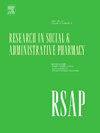在药物审查过程中明确药剂师临床推理的图形模型。
IF 3.7
3区 医学
Q1 PUBLIC, ENVIRONMENTAL & OCCUPATIONAL HEALTH
Research in Social & Administrative Pharmacy
Pub Date : 2024-09-17
DOI:10.1016/j.sapharm.2024.09.005
引用次数: 0
摘要
药剂师的角色已从传统的配药和发药发展到以患者为中心的临床服务。药剂师的临床推理虽然是这些新角色的基础,但通常仍然是隐性的,研究不足,尤其是与医生等其他医疗保健专业人员的临床推理相比。然而,要对药剂师提供的临床服务进行教学和监督,就必须充分了解其中的推理过程。目前已开发出多个描述药剂师临床推理的模型,但这些模型缺乏统一的映射。在此,我们采用工具性案例研究方法,建立了药剂师在用药审核过程中的临床推理模型。我们的模型改编自之前发表的医生临床推理的认知复杂性建模-使用-典型对象模型。我们的药剂师模型是经过反复开发和专家咨询后验证的,它将药剂师临床推理的组成部分与医师临床推理的组成部分统一起来。临床病例包含临床相关性各异的药物相关问题,以及进行药物审查所需的大量关键要素(如实验室结果、生命体征)。该病例既是模型开发的基础,也是本文中逐步说明的示例。我们的模型描述了药师在用药审核过程中的临床推理子过程,提供了一个灵活的多路径结构,强调了推理的动态和非线性性质。该模型或许能够澄清隐含的认知过程,从而进一步实现促进学习者反思性技能发展的总体目标,而不是仅仅依赖于通过实践经验获得的隐性知识。本文章由计算机程序翻译,如有差异,请以英文原文为准。
A graphical model to make explicit pharmacist clinical reasoning during medication review
Pharmacists’ roles have evolved substantially from traditional drug compounding and dispensing to encompass patient-centred clinical services. Pharmacist clinical reasoning, though fundamental to these new roles, generally remains implicit and understudied, particularly compared with that of other healthcare professionals, such as physicians. However, teaching and supervising the clinical services provided by pharmacists require a thorough understanding of the reasoning process involved. Several models describing pharmacist clinical reasoning have been developed, but they lack unified mapping.
Here, we used an instrumental case study approach to develop a model of pharmacist clinical reasoning during medication review. Our model is adapted from a previously published modelling-using-typified-objects model of physician clinical reasoning in all its cognitive complexity. Our pharmacist model, validated after iterative development and expert consultation, aligns components of pharmacist clinical reasoning with those of physician clinical reasoning. The clinical case contains drug-related problems of variable clinical relevance, as well as numerous key elements (e.g., laboratory results, vital signs) necessary for conducting a medication review. The case serves both as the foundation for model development and as an illustrative step-by-step example within this article.
Our model delineates the subprocesses of pharmacist clinical reasoning during medication review, offering a flexible, multipath structure that underscores the dynamic, nonlinear nature of the reasoning. The model might be able to clarify implicit cognitive processes, thus furthering the overarching objective of promoting reflective skill development among learners rather than relying solely on tacit knowledge gained through practice experience.
求助全文
通过发布文献求助,成功后即可免费获取论文全文。
去求助
来源期刊

Research in Social & Administrative Pharmacy
PUBLIC, ENVIRONMENTAL & OCCUPATIONAL HEALTH-
CiteScore
7.20
自引率
10.30%
发文量
225
审稿时长
47 days
期刊介绍:
Research in Social and Administrative Pharmacy (RSAP) is a quarterly publication featuring original scientific reports and comprehensive review articles in the social and administrative pharmaceutical sciences. Topics of interest include outcomes evaluation of products, programs, or services; pharmacoepidemiology; medication adherence; direct-to-consumer advertising of prescription medications; disease state management; health systems reform; drug marketing; medication distribution systems such as e-prescribing; web-based pharmaceutical/medical services; drug commerce and re-importation; and health professions workforce issues.
 求助内容:
求助内容: 应助结果提醒方式:
应助结果提醒方式:


